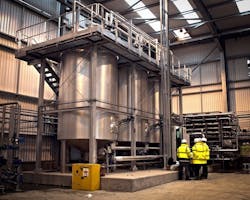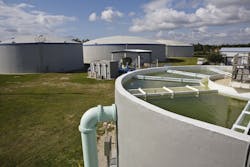About the author:
Matt Hale is International Sales & Marketing Director for HRS Heat Exchangers. Hale can be reached at [email protected].
It is being increasingly recognized that wastewater, rather than just being a waste product, can be a valuable resource. Not only does recovering and reusing water reduce the environmental and financial costs associated with treatment and discharge, but these processes also can provide products, such as biomethane nutrients and other valuable chemicals.
Reclaimed water can be used for processes such as cooling and cleaning, irrigation and habitat creation. If coupled with additional appropriate technologies such as ultraviolet (UV) light or ozone treatment, it is possible to produce clean potable water from wastewater sources, while also recovering energy and materials during earlier treatment stages.
Whether through recovering heat from treated water, generating energy from biogas produced by anaerobic digestion (AD), or recovering valuable compounds such as phosphorus, alcohols or sugars, energy-efficient water treatment will prevent money from going down the drain.
“Over the years, wastewater companies have adopted different approaches to sludge treatment, but there is now a trend towards the use of AD and away from incineration,” said Cameron Creech, sales manager for HRS USA. “There are now more than 1,250 treatment works utilizing AD across the U.S., either through on-site digestion or by sending solids for treatment at other AD facilities. However, there are still huge opportunities to increase the energy and resources recovered, and to do so in a more efficient manner. For example, the Water Environment Research Foundation (WERF) says that investing in the 100 largest wastewater plants across the country could reduce the sector’s energy use by 17%.”
The Potential of Wastewater
WERF believes the total available energy in the wastewater sector across the country is as much as 851 trillion BTUs per year, or five times the energy currently required for the treatment of domestic wastewater nationwide. The wastewater industry has the potential to be a net exporter of energy, 20% of which is chemical energy—captured by technologies like AD—and 80% of which is thermal energy, which can be utilized using heat exchangers.
Around the world there has been a trend as many wastewater AD facilities have switched from producing electricity via combined heat and power to instead produce green gas, specifically biomethane, for export because it can be used as transport fuel. Such changes have been driven by government policies and support in the form of incentive payments and feed-in tariffs, but across the globe small-scale efficiency improvements also have been important in boosting the wastewater sector’s energy output.
“Upgrading an existing plant presents an ideal opportunity to improve its overall efficiency, to maximize both energy production and overall greenhouse gas savings,” Creech said. “One of the easiest ways to improve efficiency is by capturing useful heat, and heat exchangers represent the best way of doing this. When used for pasteurization for example, they have a much lower heat requirement than tanks with heating jackets [up to half of that of some systems]. In fact, a well-designed heat exchanger system could recover and reuse 40% of the heat produced by a wastewater AD plant.”
However, not all heat exchangers are equal and one size does not fit all. The AD industry covers many different sectors processing a variety of feedstocks from food waste to farm residues, to liquid by-products. Double tube heat exchangers, such as the DTI Series from HRS Heat Exchangers, often are popular. The DTI Series has an inner tube that is corrugated to ensure improved heat transfer performance and superior resistance against tube wall fouling, resulting in reduced maintenance periods. In addition, the tube-in-tube design permits the processing of fluids with particles without any tube blockage, making it particularly suited for sewage AD plants.
Utilizing Recovered Heat
Recovering heat is only the first step. It then needs to be used for something useful for the process to truly be efficient. Heat can be utilized in the AD process itself. For example, recovered heat can pre-heat feedstock or digesters to improve gas production efficiency whereever that heat is required; can be used for water treatment, pasteurization and concentration processes in offices, for space heating, or to heat water for cleaning. Using surplus heat in this way is free and does not need additional fuel. All of these applications can be carried out using a heat exchanger and such an approach can provide more efficient options for pasteurization or concentration.
Heat also can be used to separate water from digestate by concentration. With a typical 1.5 MW wastewater AD plant producing as much as 44,100 tons of liquid digestate each year–bringing economic and logistical challenges associated with its storage and transportation–many operators are using their surplus heat to improve their digestate management systems. After all, if it is not concentrated, the volume and consistency of digestate can quickly become a costly bottleneck in plant efficiency.
Concentrated Digestate is Easier to Manage
Using surplus heat to separate water from digestate by concentration can reduce the overall quantity of digestate by as much as 80%, greatly lowering the associated storage and transport costs. A well-designed system will include measures to retain the valuable nutrients in the digestate, while the evaporated water can be condensed and returned to the front end of the AD process, reducing the amount of energy and water used by the plant. After concentration, the treated digestate dry solid content can be as much as 20%, making it easier and cheaper to transport and handle.
Going Beyond Clean Water to No Water
Zero liquid discharge (ZLD) involves transforming liquid waste streams from industrial plants into clean water, which can be reused in the process. The minimum amount of solid residues, which often include valuable byproducts, can then be sold or reused. Although every ZLD system will be different, many will comprise a pre-treatment phase, an evaporation phase to remove most of the water, and a further concentration or crystallization phase to produce the final solid residue.
Pre-treatment often focuses on removing organic elements and any chemicals which could damage other equipment. As ZLD has become more widely used, more techniques have been employed at this stage, with varying levels of success. Most common water treatments, such as pH adjustment, flocculation, membrane processing, degasification, oxidation, separation and even aerobic and anaerobic digestion, have all been used as pre-treatments for ZLD systems.
Traditionally, vapor compression evaporation has been the main method employed for ZLD processing, with evaporation typically recovering around 95% of wastewater as distillate. Any remaining concentrate is then further treated physically or chemically to produce solid residues and water. Evaporators used in ZLD systems often are run at lower pressures in order to reduce the boiling point of the liquid being treated.
One approach to ZLD comprises the following steps:
- Evaporation and concentration: A concentrated solution is taken from an existing multi-effect evaporator to a second evaporator, resulting in a solution containing elevated salt levels which are close to the saturation point.
- Cooling: The solution is then cooled to provoke the formation of salt crystals.
- Crystallization: Further crystallization occurs in specially designed crystallization tanks. The crystals that are formed are captured, leaving a supernatant layer of concentrated solution. This is returned to the second evaporator for reprocessing.
Both the evaporation and cooling steps result in a high degree of material fouling on the inside of the equipment, therefore, a heat exchanger which can cope with such tough operating parameters is necessary.
Online delivery of this fully finished paper can reach you in almost any state earlier than you anticipate! Get used to obtaining papers in the arrangement you purchase. You will require APA format for a single area and MLA for a different. And such formats such as Turabian, Chicago and Harvard could be a desirable option. Obtaining essays for sale online is a fantastic idea in the end!
“The level of concentration required for ZLD systems of this type means that the product concentration will have to be above the saturation point, and so solid crystals will appear in the solution,” Creech said. “Solid-liquid mixtures are difficult to handle in a process installation; therefore, a research study is done to evaluate the nature of the saturated product. The evaporator concentrates and removes pure water from the solution, which can be used elsewhere. The coolers and crystallizers produce solid crystals and the remaining solution returns to the evaporation process. No liquid waste stream remains after the process. This way, any waste management costs are reduced to an absolute minimum.”


